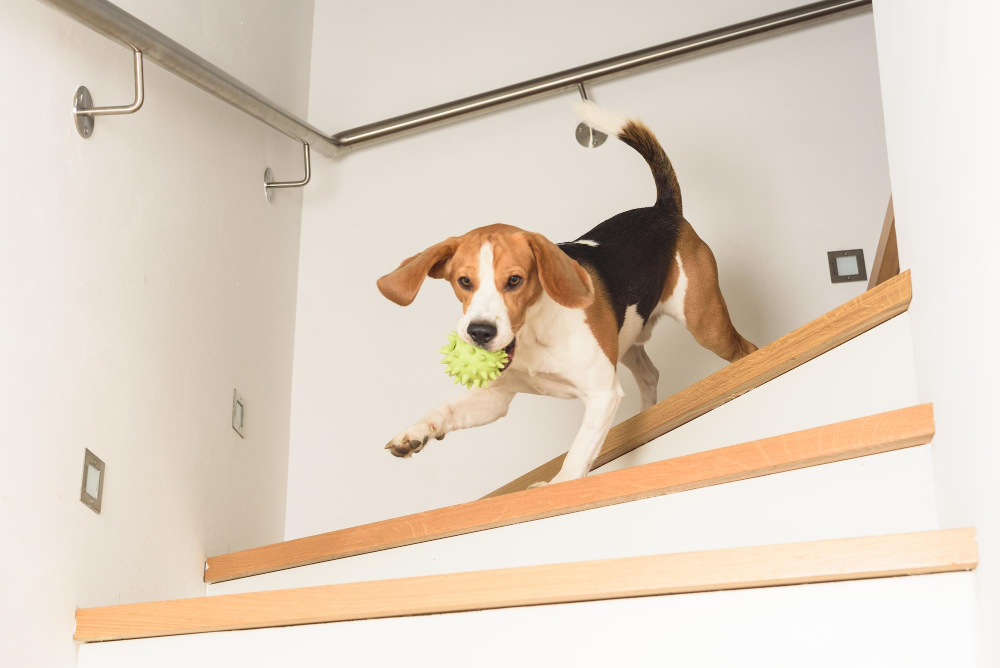Even though your dog is your best buddy, she is not entitled to the same privileges as you when it comes to moving about the house. For example, the stairs in your home may look like an obstacle course, but they’re just another part of the building.
You usually don’t mind his neediness, but now it seems excessive. For instance, he insists on sleeping in your bed every night. If you refuse to let him sleep with you, he will cry loudly at the door until you give in.
A week is possible for training. But if you try to break a lifetime habit, you can expect to put in at least a month’s effort. Your companion will be eternally thankful if you take the time to train them properly. On top of that, your dog will appreciate the alone time during the day.
It can be challenging to train a dog to sleep on the ground floor if it has been accustomed to sleeping upstairs for a long time. Changing around his schedule may be the key to finally breaking him of this bad habit.
Finding the correct inducement to bring him downstairs will also be necessary. Finally, you’ll have to muster all the determination and fortitude you can to overcome the challenges you set for yourself.
If you can get him to stay downstairs, you’ll have some peace and quiet. It will also protect him from ever experiencing fear when you have to leave the house. Without practice being alone, he will be utterly despondent every time you have to leave for work.
How Do I Keep My Dog Downstairs?
You’ll need a few things before you can start training. First, you’ll want to install some baby gates across the stairwell. Next, you’ll need a choke chain and a water spray bottle.
- Start by teaching your dog that the upstairs is off-limits. Consistency in your training is essential before you even begin. Get her some time alone in another room with her favorite chew toy and some treats.
- If you discover her upstairs, you should bring her down by picking her up or grabbing her by the collar. Then, redirect her attention downstairs by saying “downstairs” in a strong, commanding tone. Your dog will eventually catch on to the meaning of that word if she hears it frequently enough.
- To create a temporary barrier that can be removed with ease, set up a baby gate or pet gate at the bottom of the steps. Most dogs don’t like having to deal with gates, therefore they generally recognize them as boundaries that shouldn’t be breached. Some gates are meant to be installed permanently and feature hinges that allow them to be opened and closed with the swing of a door. Some can be pressure-mounted, so they won’t damage the walls or stair rails.
- While you’re away from the house, keep your dog in a crate. Teaching your puppy to stay in her crate is a great method to prevent her from getting into mischief and provide her with a secure environment to rest and unwind while you’re away.
- It would help if you also prepared by gathering a sufficient supply of snacks. You can use these to encourage your dog to learn new behaviors during training. It would help if you aimed to train for 10 minutes every day, preferably at a time when you won’t be interrupted by household noise.
- It would help if you also prepared by gathering a sufficient supply of snacks. You can use these to encourage your dog to learn new behaviors during training. It would help if you aimed to train for 10 minutes every day, preferably at a time when you won’t be interrupted by household noise.
Why Does My Dog Want To Go Upstairs?
Your dog may be going upstairs because it has learned that doing so would result in positive reinforcement, separation anxiety, or because it enjoys the novelty of the situation. Though, there are a few factors you can look at to assist you in identifying the primary reason and a few issues you can do to resolve the question.
Anxiety when separated
Your dog may have been acting this way because they suffer from separation anxiety. This is more likely to happen if your dog only attempts to ascend the stairs when you are on the upper level.
Boredom
Your dog may be asking for attention and activity because they are bored. If your dog has a pattern of doing this right before receiving exercise or after sitting still for a while, boredom could be the issue.
Prompting the action
Your dog may have learned this is a desirable behavior and now expects it whenever he receives a treat. If you consistently reward them with something when they go upstairs, whether it’s a toy, a treat, or your undivided attention, they’ll likely start doing it more often.
Skittishness
It’s also possible that they’ve recently been afraid for no apparent reason. However, if they have a habit of doing it, say, if there are loud noises downstairs, your dog might be skittish.
Why Should Dogs Not Go Upstairs?
Stair training is difficult for a puppy in and of itself, but it also presents certain dangers. Puppies, especially those of smaller breeds, can quickly lose their balance and fall.
Broken bones, spinal troubles, brain injuries, sprains, and even psychiatric fear of the steps are all possible outcomes of a fall with your dog, depending on its breed, age, and intensity.
Hip dysplasia or arthritis are heritable conditions that disproportionately affect large breeds. Stairs can exacerbate or hasten the development of these issues in puppies of various breeds. At the very least, a year should pass between when you have a puppy and when you let it roam free and climb the stairs.
Stair climbing can be very uncomfortable and risky for dogs who have recently undergone medical procedures involving stitches, such as standard spaying. Your dog’s cone of shame, which the vet probably put around its neck, is another potential trip hazard.














